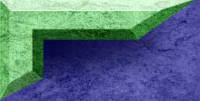Awl~ An indispensable tool for punching holes in book board, signatures, paper, etc.
Beeswax~ Use this to wax your linen thread before sewing. Beaders often use it to wax beading threads prior
to beading. Really makes your sewing go quicker and easier. A little can also be used to bring the edges
of a leather journal to a high gloss.
Binder's Linen Thread~ This is used to sew the signatures of a book together. If you want your knot patterns
to show, as in a coptic stitch, a heavier linen thread would be helpful.
Binder's Needles~ Needles are used to sew the signatures of a book together. They typically have a larger
eye to accomodate your threads.
Book Board~ An acid free, heavy duty board made for book binders. It is much better than chipboard in book making
because it is not 2 pieces glued together and resists warping.
Book Cloth~ A fabric backed with a barrier (usually paper) to prevent glue seepage.
Book EZ Tool~ An indispensable tool to space your holes quickly and evenly, created by Articus Studio. After marking
your holes for punching, and punching your holes, they can be removed to decorate the pages and quickly assembled back together
and the holes will line up beautifully ever time. This should be available in March, 2005.
Book Press~Used to prevent glued materials from warping while drying. A makeshift press can be made by using 2 smooth
boards and a few heavy books or bricks. Put your glued project between the boards and use the books or bricks to hold
them secure while drying. For smaller projects, heavy books alone will suffice. There are also instructions out
there to make one if so inclined.
Bone Folder~This tool is used for folding, scoring & creasing papers. It is also great for pressing out air bubbles
and wrinkles when gluing papers & fabrics to other surfaces. It is very useful!
Dremel Tool~ Used to drill holes in signatures, book board and any stack of paper and light boards. I prefer this
method in my own book making. It is also called a rotary tool, but I think most people would recognize it by the brand
name, Dremel. It comes with many attachments and is also useful in many other craft applications.
Folio~ A piece of paper folded in half is called a folio and usually folios are nested together to form a signature.
Headband~ If you have noticed the little band of cloth at the top & bottom of the inside of the spine of books this
is the headband. It adds a nice finishing touch-mostly for show. It does help keep dust out of the spine of a
book. Some bookbinders call it "endband".
Hole Punching Cradle~ A tool used for cradling your signatures so that you can use your awl to punch holes in them evenly.
Japanese Screw Punch~ Used to punch holes in a stack of papers and light boards. Personally, I prefer
and use a rotary tool, commonly called by their brand name, Dremel.
Linen Tape~ When sewing a book by hand, it is common to sew over tapes.
Mitering~The process of cutting, folding and fitting paper over the corners of the bookboards they cover for a clean, smooth
edge.
Paper Grain~Bookboard and most commercially made papers have a grain. This is the direction in which the fibers the
paper are made from align themselves. If a sheet of paper folds easily then you are bending with the grain. If,
when you fold the paper, resistance is met, then you are folding against the grain. Papers folded against the grain
will not have an even crease in them and may crack and just be uncooperative. Paper folded with the grain will crease
easier without cracking, crease evenly and hold its shape well.
Scoring~This is the process of using a bone folder, awl or some other tool to crease paper. This makes it much easier
to fold papers because it breaks the fibers in the paper to make it easier to fold and crease with a sharper fold line.
Signature~ Each nested group of pages is called a signature. It is also called a section or gathering. In Europe
they were called "quires". A book can have one signature or many.

